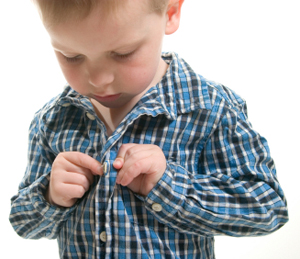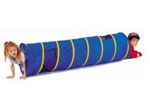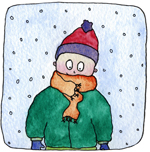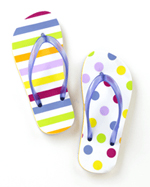
Parenting  Start with heavy work. Warming up the muscles with exercise is a great way to reduce sensitivity. Occupational therapists define “heavy work” as any activity that puts deep pressure on the joints of the upper body, such as pushing a laundry basket or crawling through a tunnel.
Start with heavy work. Warming up the muscles with exercise is a great way to reduce sensitivity. Occupational therapists define “heavy work” as any activity that puts deep pressure on the joints of the upper body, such as pushing a laundry basket or crawling through a tunnel.
 Know exactly what type of clothing to look for: soft, breathable fabrics, tagless, covered elastic bands, no metal parts, no heavy embroidery or applique. Softclothing.net offers thousands of soft clothing items for your sensory sensitive child.
Additionally accept hand-me-downs whenever possible and shop at used clothing stores for softer fabrics.
Know exactly what type of clothing to look for: soft, breathable fabrics, tagless, covered elastic bands, no metal parts, no heavy embroidery or applique. Softclothing.net offers thousands of soft clothing items for your sensory sensitive child.
Additionally accept hand-me-downs whenever possible and shop at used clothing stores for softer fabrics.
Believe your child when he or she says that clothing is irritating. Use the opportunity to find a solution to the problem together. Wearing a tagless undershirt increases overall comfort; substituting cotton jersey leggings for tights makes wearing a skirt much more pleasant.
Allow the child to select clothing as often as possible. My 5 year old sometimes likes to dress all in black “just like Darth Vader.” At other times he wants to dress in a roller coaster or monster truck theme. This type of experimentation increases his sensory tolerance.
 around the hips. Smart Knit Kids makes seamless socks and underwear that are designed to minimize irritation for sensitive children.
Some families, including mine, find that tagless boys’ boxer briefs with covered waistbands are the most comfortable for boys and girls - the elastic bands around the groin area can be very painful on standard boys' and girls' briefs. My kids also prefer socks that are slightly too small because they fit more tightly and don’t bunch up inside their shoes.
around the hips. Smart Knit Kids makes seamless socks and underwear that are designed to minimize irritation for sensitive children.
Some families, including mine, find that tagless boys’ boxer briefs with covered waistbands are the most comfortable for boys and girls - the elastic bands around the groin area can be very painful on standard boys' and girls' briefs. My kids also prefer socks that are slightly too small because they fit more tightly and don’t bunch up inside their shoes.
 Be flexible about dressing for the weather. My 10 year old son insists on wearing long sleeves and long pants all year round, because he does not like the feeling of air on his arms and legs. When he was a toddler, he refused to put on a coat or mittens on the coldest days of winter.
My strategy is to allow him to choose his clothing, but I carry the back-up clothing for the moment when the reality of the outside temperature hits him. “Oh, you’re sweaty and overheated? Here’s a short-sleeve t-shirt.” “You’re shivering. Here’s a hat. Oh, now your fingers are cold? I have some mittens right here.” It works every time.
Be flexible about dressing for the weather. My 10 year old son insists on wearing long sleeves and long pants all year round, because he does not like the feeling of air on his arms and legs. When he was a toddler, he refused to put on a coat or mittens on the coldest days of winter.
My strategy is to allow him to choose his clothing, but I carry the back-up clothing for the moment when the reality of the outside temperature hits him. “Oh, you’re sweaty and overheated? Here’s a short-sleeve t-shirt.” “You’re shivering. Here’s a hat. Oh, now your fingers are cold? I have some mittens right here.” It works every time.
 It’s not OK to walk down the street naked in any weather. Make sure that your child understands the difference between socially appropriate and inappropriate dress. Point out how other people are dressed when you are running errands or at school.
Explain the natural consequences of inappropriate dress such as, “You weren’t wearing your rain boots, so your shoes got wet” or “We can’t get ice cream, because the sign says you have to wear a shirt in the store.”
It’s not OK to walk down the street naked in any weather. Make sure that your child understands the difference between socially appropriate and inappropriate dress. Point out how other people are dressed when you are running errands or at school.
Explain the natural consequences of inappropriate dress such as, “You weren’t wearing your rain boots, so your shoes got wet” or “We can’t get ice cream, because the sign says you have to wear a shirt in the store.”
 Sometimes the only way to get a child to wear any shoes at all is to allow sandals or flip-flops. But there’s a downside. I’ve known many children over the years who refuse to give up their sandals at the end of summer.
Wearing sandals can prevent certain activities - indoor playgrounds require socks and outdoor playgrounds usually have wood chips, which can splinter inside the sandal. It’s also unsafe to run or climb in sandals.
These physical activities are absolutely necessary for highly sensitive children. Therefore, I ask my children to wear sneakers with socks unless we are going to the beach, as an extension of my lessons about social norms.
Sometimes the only way to get a child to wear any shoes at all is to allow sandals or flip-flops. But there’s a downside. I’ve known many children over the years who refuse to give up their sandals at the end of summer.
Wearing sandals can prevent certain activities - indoor playgrounds require socks and outdoor playgrounds usually have wood chips, which can splinter inside the sandal. It’s also unsafe to run or climb in sandals.
These physical activities are absolutely necessary for highly sensitive children. Therefore, I ask my children to wear sneakers with socks unless we are going to the beach, as an extension of my lessons about social norms.
 Choose pajamas and blankets to get a good night’s rest. Tired, cranky kids are hypersensitive and my kids are both night-wakers. My older son now uses an eight-pound weighted blanket at night; but my younger son still refuses any blanket, and sometimes he wakes up because he’s cold.
If he wears warmer fleece pajamas, he gets sweaty and wakes up because of the wetness. I finally solved the problem by having him wear his usual cotton knit pajamas with a footed fleece sleeper on top. The breathable cotton fabric prevented the clamminess on his skin, and the fleece sealed in his warmth, and he started sleeping through the night.
Choose pajamas and blankets to get a good night’s rest. Tired, cranky kids are hypersensitive and my kids are both night-wakers. My older son now uses an eight-pound weighted blanket at night; but my younger son still refuses any blanket, and sometimes he wakes up because he’s cold.
If he wears warmer fleece pajamas, he gets sweaty and wakes up because of the wetness. I finally solved the problem by having him wear his usual cotton knit pajamas with a footed fleece sleeper on top. The breathable cotton fabric prevented the clamminess on his skin, and the fleece sealed in his warmth, and he started sleeping through the night.
 Choose vitamin and mineral supplements to reduce sensitivity. There is substantial evidence demonstrating that vitamin and mineral deficiencies can contribute to sensitivities. Highly sensitive children often have self-limited diets as well, which means they need extra nutrition. Consult with your child’s pediatrician about the vitamin combination that will work best for your child.
Choose vitamin and mineral supplements to reduce sensitivity. There is substantial evidence demonstrating that vitamin and mineral deficiencies can contribute to sensitivities. Highly sensitive children often have self-limited diets as well, which means they need extra nutrition. Consult with your child’s pediatrician about the vitamin combination that will work best for your child.
10 Tips for dressing a sensory sensitive child
My 5 year old son just informed me that he will no longer wear his Thomas the Train sweater, because it is too itchy. He takes after me. When I was a kid, clothing tags were my enemies. I used to get my mother’s sewing scissors and cut the tags out as soon as I got new clothes. I preferred hand-me-downs from my sisters, because the worn fabric was softer and the tags were already removed. Exposed elastic bands were too tight on me, even though I was a skinny kid, and left painful red marks on my skin. I never wanted to wear skirts, because my tights were too itchy, and if I didn’t wear tights under the skirt, my knees became cold and achy, even in warm weather. Getting dressed can be a battle for children who are highly sensitive or who have neurological differences. Here are 10 ideas to reduce the stress while getting dressed.1. Heavy Work
 Start with heavy work. Warming up the muscles with exercise is a great way to reduce sensitivity. Occupational therapists define “heavy work” as any activity that puts deep pressure on the joints of the upper body, such as pushing a laundry basket or crawling through a tunnel.
Start with heavy work. Warming up the muscles with exercise is a great way to reduce sensitivity. Occupational therapists define “heavy work” as any activity that puts deep pressure on the joints of the upper body, such as pushing a laundry basket or crawling through a tunnel.
2. Soft Clothing
 Know exactly what type of clothing to look for: soft, breathable fabrics, tagless, covered elastic bands, no metal parts, no heavy embroidery or applique. Softclothing.net offers thousands of soft clothing items for your sensory sensitive child.
Additionally accept hand-me-downs whenever possible and shop at used clothing stores for softer fabrics.
Know exactly what type of clothing to look for: soft, breathable fabrics, tagless, covered elastic bands, no metal parts, no heavy embroidery or applique. Softclothing.net offers thousands of soft clothing items for your sensory sensitive child.
Additionally accept hand-me-downs whenever possible and shop at used clothing stores for softer fabrics.
 3. Find Alternatives
3. Find Alternatives
Believe your child when he or she says that clothing is irritating. Use the opportunity to find a solution to the problem together. Wearing a tagless undershirt increases overall comfort; substituting cotton jersey leggings for tights makes wearing a skirt much more pleasant.
 4. Let Your Child Choose
4. Let Your Child Choose
Allow the child to select clothing as often as possible. My 5 year old sometimes likes to dress all in black “just like Darth Vader.” At other times he wants to dress in a roller coaster or monster truck theme. This type of experimentation increases his sensory tolerance.
5. Find The Right Undergarments
Make sure that socks and underwear are as comfortable as possible. An entire day can be ruined by rebellious socks that get bunched up inside shoes or underwear that chafes around the hips. Smart Knit Kids makes seamless socks and underwear that are designed to minimize irritation for sensitive children.
Some families, including mine, find that tagless boys’ boxer briefs with covered waistbands are the most comfortable for boys and girls - the elastic bands around the groin area can be very painful on standard boys' and girls' briefs. My kids also prefer socks that are slightly too small because they fit more tightly and don’t bunch up inside their shoes.
around the hips. Smart Knit Kids makes seamless socks and underwear that are designed to minimize irritation for sensitive children.
Some families, including mine, find that tagless boys’ boxer briefs with covered waistbands are the most comfortable for boys and girls - the elastic bands around the groin area can be very painful on standard boys' and girls' briefs. My kids also prefer socks that are slightly too small because they fit more tightly and don’t bunch up inside their shoes.
6. Don't Always Dress For The Weather
D Be flexible about dressing for the weather. My 10 year old son insists on wearing long sleeves and long pants all year round, because he does not like the feeling of air on his arms and legs. When he was a toddler, he refused to put on a coat or mittens on the coldest days of winter.
My strategy is to allow him to choose his clothing, but I carry the back-up clothing for the moment when the reality of the outside temperature hits him. “Oh, you’re sweaty and overheated? Here’s a short-sleeve t-shirt.” “You’re shivering. Here’s a hat. Oh, now your fingers are cold? I have some mittens right here.” It works every time.
Be flexible about dressing for the weather. My 10 year old son insists on wearing long sleeves and long pants all year round, because he does not like the feeling of air on his arms and legs. When he was a toddler, he refused to put on a coat or mittens on the coldest days of winter.
My strategy is to allow him to choose his clothing, but I carry the back-up clothing for the moment when the reality of the outside temperature hits him. “Oh, you’re sweaty and overheated? Here’s a short-sleeve t-shirt.” “You’re shivering. Here’s a hat. Oh, now your fingers are cold? I have some mittens right here.” It works every time.
7. Reinforce social norms
 It’s not OK to walk down the street naked in any weather. Make sure that your child understands the difference between socially appropriate and inappropriate dress. Point out how other people are dressed when you are running errands or at school.
Explain the natural consequences of inappropriate dress such as, “You weren’t wearing your rain boots, so your shoes got wet” or “We can’t get ice cream, because the sign says you have to wear a shirt in the store.”
It’s not OK to walk down the street naked in any weather. Make sure that your child understands the difference between socially appropriate and inappropriate dress. Point out how other people are dressed when you are running errands or at school.
Explain the natural consequences of inappropriate dress such as, “You weren’t wearing your rain boots, so your shoes got wet” or “We can’t get ice cream, because the sign says you have to wear a shirt in the store.”
8. Open-toe or closed-toe?
 Sometimes the only way to get a child to wear any shoes at all is to allow sandals or flip-flops. But there’s a downside. I’ve known many children over the years who refuse to give up their sandals at the end of summer.
Wearing sandals can prevent certain activities - indoor playgrounds require socks and outdoor playgrounds usually have wood chips, which can splinter inside the sandal. It’s also unsafe to run or climb in sandals.
These physical activities are absolutely necessary for highly sensitive children. Therefore, I ask my children to wear sneakers with socks unless we are going to the beach, as an extension of my lessons about social norms.
Sometimes the only way to get a child to wear any shoes at all is to allow sandals or flip-flops. But there’s a downside. I’ve known many children over the years who refuse to give up their sandals at the end of summer.
Wearing sandals can prevent certain activities - indoor playgrounds require socks and outdoor playgrounds usually have wood chips, which can splinter inside the sandal. It’s also unsafe to run or climb in sandals.
These physical activities are absolutely necessary for highly sensitive children. Therefore, I ask my children to wear sneakers with socks unless we are going to the beach, as an extension of my lessons about social norms.
9. Choose your sleepwear carefully
 Choose pajamas and blankets to get a good night’s rest. Tired, cranky kids are hypersensitive and my kids are both night-wakers. My older son now uses an eight-pound weighted blanket at night; but my younger son still refuses any blanket, and sometimes he wakes up because he’s cold.
If he wears warmer fleece pajamas, he gets sweaty and wakes up because of the wetness. I finally solved the problem by having him wear his usual cotton knit pajamas with a footed fleece sleeper on top. The breathable cotton fabric prevented the clamminess on his skin, and the fleece sealed in his warmth, and he started sleeping through the night.
Choose pajamas and blankets to get a good night’s rest. Tired, cranky kids are hypersensitive and my kids are both night-wakers. My older son now uses an eight-pound weighted blanket at night; but my younger son still refuses any blanket, and sometimes he wakes up because he’s cold.
If he wears warmer fleece pajamas, he gets sweaty and wakes up because of the wetness. I finally solved the problem by having him wear his usual cotton knit pajamas with a footed fleece sleeper on top. The breathable cotton fabric prevented the clamminess on his skin, and the fleece sealed in his warmth, and he started sleeping through the night.
10. Use Vitamins
 Choose vitamin and mineral supplements to reduce sensitivity. There is substantial evidence demonstrating that vitamin and mineral deficiencies can contribute to sensitivities. Highly sensitive children often have self-limited diets as well, which means they need extra nutrition. Consult with your child’s pediatrician about the vitamin combination that will work best for your child.
Choose vitamin and mineral supplements to reduce sensitivity. There is substantial evidence demonstrating that vitamin and mineral deficiencies can contribute to sensitivities. Highly sensitive children often have self-limited diets as well, which means they need extra nutrition. Consult with your child’s pediatrician about the vitamin combination that will work best for your child. 


